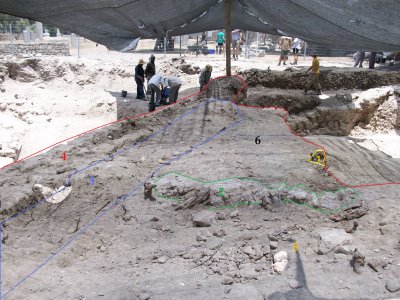
"How misty was it?" you might ask, assuming that you're old enough to remember Johnny Carson. And assuming that you thought I was looking for that particular response. Honestly, it's not a terribly likely chain of events.
However, if you did want to know just how misty it was, the next picture should give some information in that regard; that's what it looked like when I tried to take a picture with the flash on -- there was a lot of water in the air, indeed.
That was all gone within an hour of us starting to dig, but it wasn't entirely forgotten -- we set up our laptops underneath a tree, in order to have sufficient shade to see the screen. And because it's a bit more comfortable. It took longer than an hour for that tree to stop dripping on us.
Nobody was electrocuted, either, so it worked out well all around.
As far as the actual digging went, at least in my square, we mostly managed to finish what I had hoped we would finish; it was a bit of a short day, though, as we got a sun shade, which took a while to set up. So the changes to the square today weren't that dramatic.
Obviously, there were changes, as you might be able to see in the next picture. Or, perhaps you can't. For one thing, one of the major projects of the day was digging a pit from the crusader period, and I seem to have neglected to take a picture of that -- there's a little bit of it on the side, there, but it's hard to see, honestly.
I've been fooling around with the settings on blogger -- I'm not sure if you're going to see the following picture well enough to make out the details without clicking through. If not, I'd suggest clicking on the picture below, with the lines drawn by my trusty assistant, MS Paint.
So, as with last time, the red line marks the edges of those parts of my square that I can excavate, at the moment. The little bit circled in yellow, with the 1 in it is the crusader period pit I mentioned earlier, which is cutting into a surface that dates to before the Crusaders. It's going to take pottery to tell us when that surface is from, but whatever it is, it's going to have to be earlier than the Crusades.
The bit circled in green, and numbered 2 is a bit confusing. It's clearly a line of stones, and it's been plastered, but that line seems to meander a bit. At the moment, I'm not sure if it relates to the surface that the crusader pit cut, or if it's something earlier or later. It's possible we'll learn more about it when we take it out, but we might not. In either case, it gives us a good boundary between the areas to the north and south of it, which we'll talk about soon.
Before that, we've got the long area circled in blue, and labeled 3. At the moment, I think it's a late trench, probably the foundation trench dug in the 1920s for Garstang's wall, which is labeled 4. One of the reasons why I think that is that it's shot through with tree roots, while the areas to the east of it aren't; material deposited later isn't going to be packed as hard as dirt that's been sitting in the same place for a thousand or two thousand years, and it'll be easier for the trees to get their roots through it.
Which leaves us with five and six, which are distinguished by not having any particular distinguishing characteristics. Much of 5 lies over the big Byzantine wall, so it's going to be later than whoever it was that took the stones from that wall -- I'm guessing Crusader, but that's a guess that's going to have to wait for pottery analysis. It's got different sorts of fill; rubble, and ash, loose dirt and harder packed dirt, but it's all sufficiently jumbled that I'm not sure if it's possible to distinguish much about it. We'll see what happens as we go down.
6 is mostly hard packed fill, and much of it seems to be of that surface that the Crusader pit goes through. While there are some complications, 6 seems to be our best bet for good layers of undisturbed archaeology. So we're not going to start there until we get a bit deeper in the areas with later material; the general rule is that you want to try and dig the later material first.


